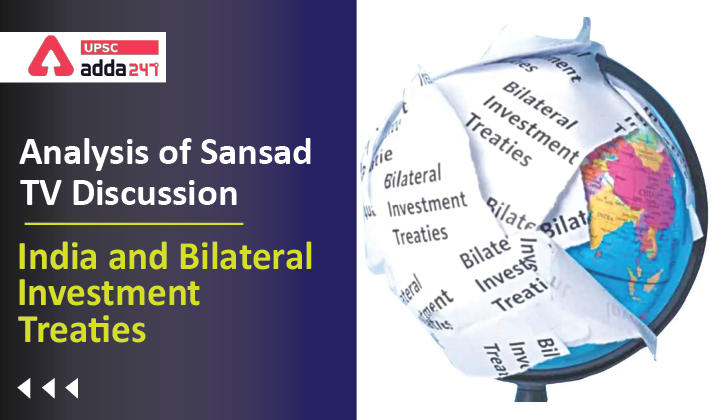Table of Contents
Context
Recently the Parliamentary Standing Committee on External Affairs submitted its report on the subject ‘India and Bilateral Investment Treaties’ on September 10, 2021.
About Parliamentary Standing Committees
- Parliamentary Committee means a Committee which is appointed or elected by the House or nominated by the Speaker and which works under the direction of the Speaker and presents its report to the House or to the Speaker and the Secretariat for which is provided by the Lok Sabha Secretariat.
- By their nature, Parliamentary Committees are of two kinds: Standing Committees and Ad hoc Committees.
- Standing Committees are permanent and regular committees that are constituted from time to time in pursuance of the provisions of an Act of Parliament or Rules of Procedure and Conduct of Business in Lok Sabha.
- The work of these Committees is of continuous nature. The Financial Committees, DRSCs and some other Committees come under the category of Standing Committees.
What are Bilateral Investment Treaties (BITs)?
- Bilateral Investment Treaties (BITs) are reciprocal agreements between two countries to promote and protect foreign private investments in each other’s territories.
- Bilateral Investment Treaty is an agreement for according protection to investments by nationals and companies of one State in another State.
- India’s tryst with Bilateral Investment treaties started in 1994 when it signed its first such treaty with the United Kingdom. It subsequently went on to sign it with more than 80 countries.
- These treaties were largely negotiated on the basis of the Indian Model BIT text of 1993. India revised its Model BIT text in 2015.
- BITs establish minimum guarantees between the two countries regarding the treatment of foreign investments, such as national treatment (treating foreign investors at par with domestic companies), fair and equitable treatment (in accordance with international law), and protection from expropriation (limiting each country’s ability to take over foreign investments in its territory.
What is the Present Status of BITs?
- Till 2015, India had signed BITs with 83 countries (of which 74 were in force). These BITs were negotiated based on the Indian Model BIT of 1993.
- India revised its Model BIT text in 2015. Since then, India has: (i) signed new BITs/Investment Agreements with only four countries and is negotiating with 37 countries/blocks, and (ii) terminated its older BITs with 77 countries (i.e., older BITs with only six countries are in force).
What are the key observations and recommendations made by the Committee?
- The Committee observed that the number of BITs/Investment Agreements signed by India after 2015 and the number under negotiation are inadequate.
- It noted that BITs have the potential to attract foreign direct investment (FDI) by providing prospective investors with a higher degree of confidence in their investments.
- In this light, the Committee recommended: (i) signing new BITs with countries with which India had such treaties in the past, (ii) signing BITs selectively in identified priority sectors, and (iii) early completion of treaty negotiations by the Ministry of External Affairs in coordination with other Ministries/Departments.
- BITs generally provide a mechanism for settling disputes between investors and the country of investment. The most preferred mode of settling such disputes is arbitration, where parties agree to have their dispute decided by a neutral person (the arbitrator) instead of going to court. The Committee recommended timely settlement of investment disputes through pre-arbitration consultation or negotiations.
- On the basis of rules and procedure, arbitration may be institutional (administered by an arbitral institution as per its rules) or ad hoc (mutually arranged by the parties).
- The Committee noted that while the Model BIT, 2015 is an improvement over the older BITs, there is still scope for fine-tuning some of its provisions (such as those regarding the investor-state dispute settlement mechanism).
- It recommended that the Model BIT should: (i) be suitably amended in light of new experience gained in disputes arising out of BITs, (ii) be reviewed continuously to ensure that it is balanced and comprehensive, and (iii) incorporate best practices and provisions from BITs adopted by advanced countries after studying in detail the implementation and outcome of such treaties.
- The Committee recommended that BITs should be drafted without any ambiguity, so as to avoid: (i) overbroad interpretation by arbitrators and tribunals, (ii) investment disputes or claims against India, and (iii) the abuse of certain provisions by investors.
- It recommended developing panels of domestic lawyers (and law firms) with: (i) the requisite expertise in investment arbitration to represent India, and (ii) experience in investment treaty law to ensure good drafting of BITs. It also recommended training government officials in the field of investment treaties and promoting the New Delhi International Arbitration Centre as a world-class arbitration centre.
Conclusion
International Investment Agreements including Bilateral Investment Treaties and Investment Chapters of Trade and Economic Agreements provide for a reciprocal commitment to protect the private foreign investments in each other’s countries. In the last few decades, Bilateral Investment Treaties have become an integral part of international investment relations. Their existence has a great impact in influencing the formulation of international public policy.



 TSPSC Group 1 Question Paper 2024, Downl...
TSPSC Group 1 Question Paper 2024, Downl...
 TSPSC Group 1 Answer key 2024 Out, Downl...
TSPSC Group 1 Answer key 2024 Out, Downl...
 UPSC Prelims 2024 Question Paper, Downlo...
UPSC Prelims 2024 Question Paper, Downlo...
